Environmental Sustainability in Construction
VerifiedAdded on 2023/06/03
|12
|3420
|294
AI Summary
This essay provides an overview of the various methods and processes which can be employed in making constructions environment friendly and at the same time sustainable, by giving due consideration to reducing the release of carbon footprint. The essay talks about the selection of construction materials having low carbon content, innovation in construction process, management of operative energy consumption and consumption behaviour, and reliance upon renewable energy system.
Contribute Materials
Your contribution can guide someone’s learning journey. Share your
documents today.
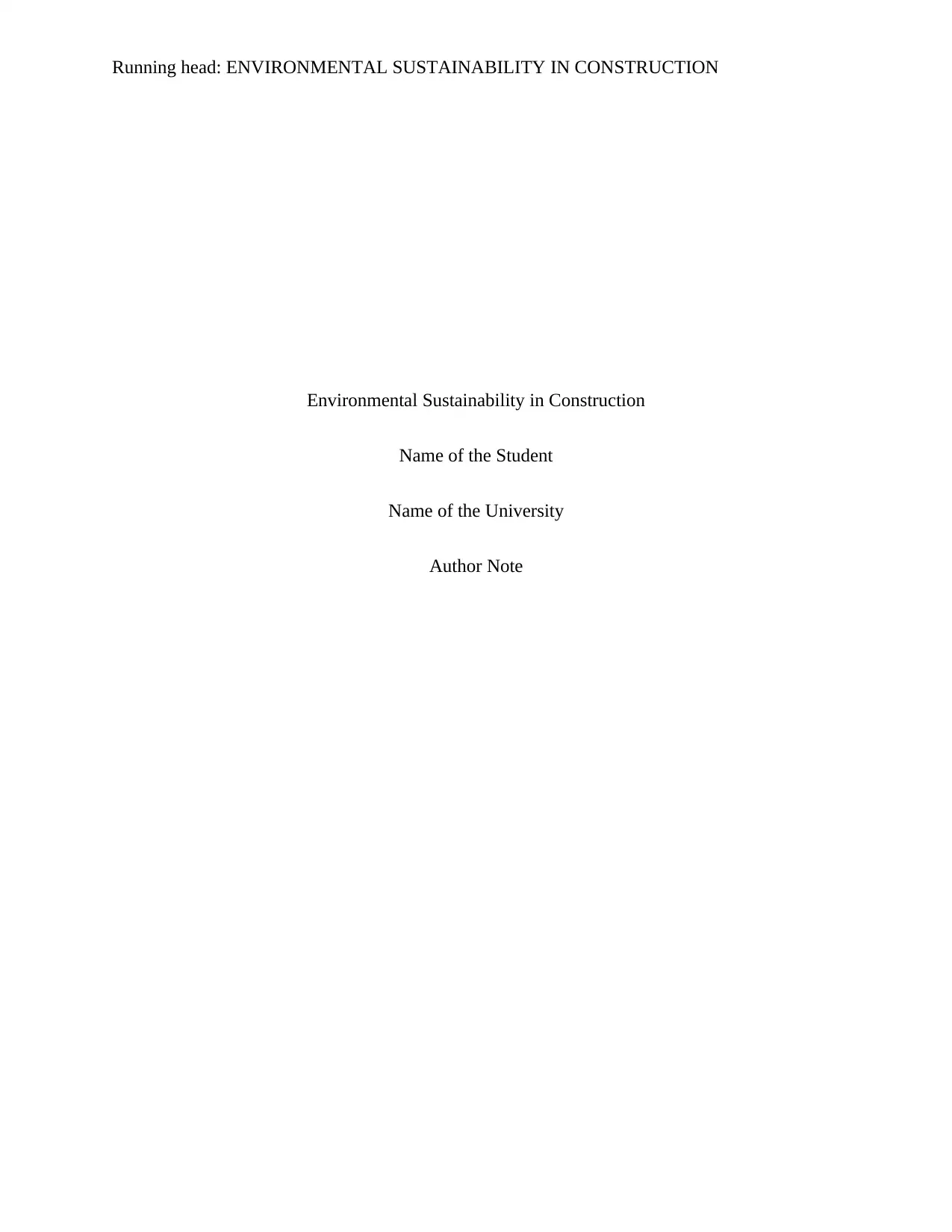
Running head: ENVIRONMENTAL SUSTAINABILITY IN CONSTRUCTION
Environmental Sustainability in Construction
Name of the Student
Name of the University
Author Note
Environmental Sustainability in Construction
Name of the Student
Name of the University
Author Note
Secure Best Marks with AI Grader
Need help grading? Try our AI Grader for instant feedback on your assignments.
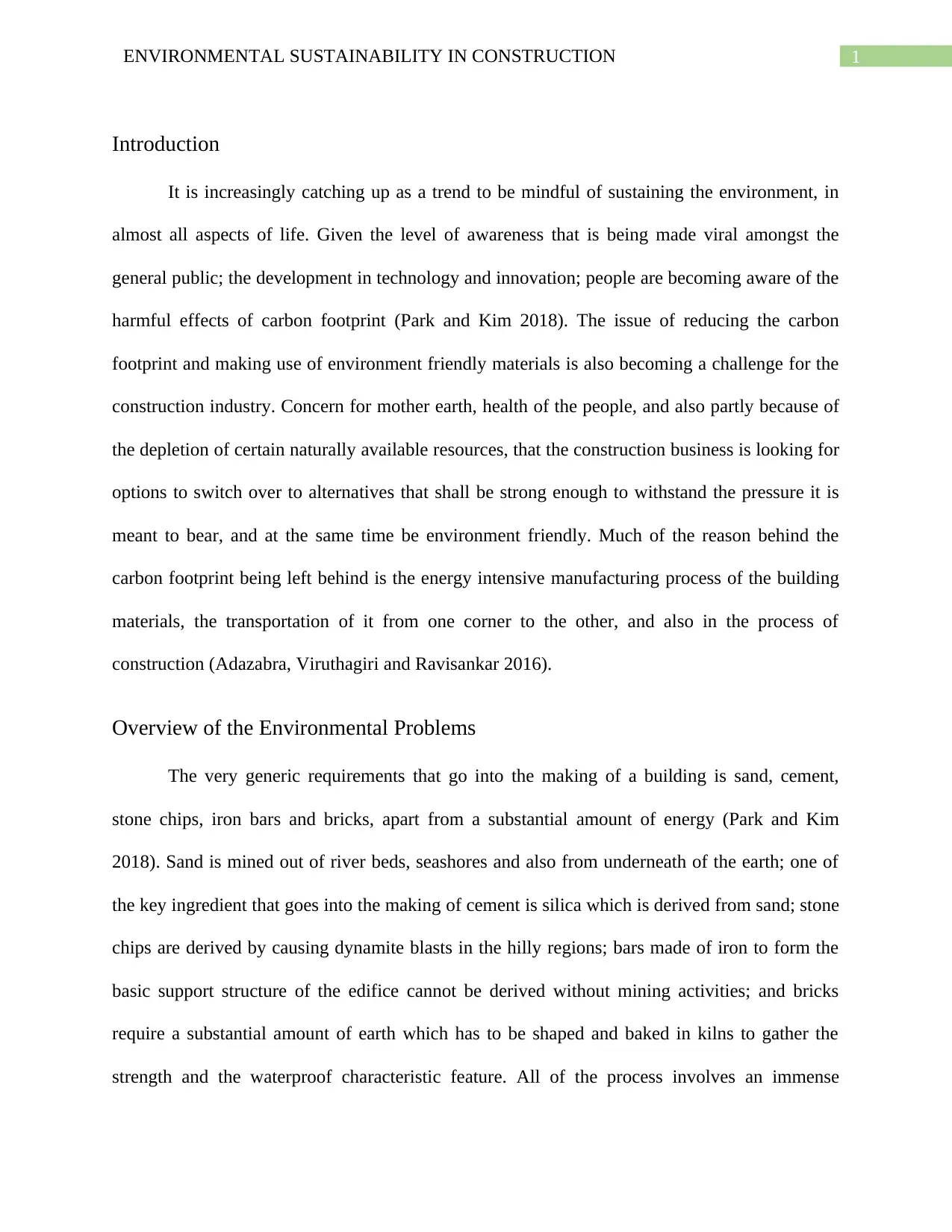
1ENVIRONMENTAL SUSTAINABILITY IN CONSTRUCTION
Introduction
It is increasingly catching up as a trend to be mindful of sustaining the environment, in
almost all aspects of life. Given the level of awareness that is being made viral amongst the
general public; the development in technology and innovation; people are becoming aware of the
harmful effects of carbon footprint (Park and Kim 2018). The issue of reducing the carbon
footprint and making use of environment friendly materials is also becoming a challenge for the
construction industry. Concern for mother earth, health of the people, and also partly because of
the depletion of certain naturally available resources, that the construction business is looking for
options to switch over to alternatives that shall be strong enough to withstand the pressure it is
meant to bear, and at the same time be environment friendly. Much of the reason behind the
carbon footprint being left behind is the energy intensive manufacturing process of the building
materials, the transportation of it from one corner to the other, and also in the process of
construction (Adazabra, Viruthagiri and Ravisankar 2016).
Overview of the Environmental Problems
The very generic requirements that go into the making of a building is sand, cement,
stone chips, iron bars and bricks, apart from a substantial amount of energy (Park and Kim
2018). Sand is mined out of river beds, seashores and also from underneath of the earth; one of
the key ingredient that goes into the making of cement is silica which is derived from sand; stone
chips are derived by causing dynamite blasts in the hilly regions; bars made of iron to form the
basic support structure of the edifice cannot be derived without mining activities; and bricks
require a substantial amount of earth which has to be shaped and baked in kilns to gather the
strength and the waterproof characteristic feature. All of the process involves an immense
Introduction
It is increasingly catching up as a trend to be mindful of sustaining the environment, in
almost all aspects of life. Given the level of awareness that is being made viral amongst the
general public; the development in technology and innovation; people are becoming aware of the
harmful effects of carbon footprint (Park and Kim 2018). The issue of reducing the carbon
footprint and making use of environment friendly materials is also becoming a challenge for the
construction industry. Concern for mother earth, health of the people, and also partly because of
the depletion of certain naturally available resources, that the construction business is looking for
options to switch over to alternatives that shall be strong enough to withstand the pressure it is
meant to bear, and at the same time be environment friendly. Much of the reason behind the
carbon footprint being left behind is the energy intensive manufacturing process of the building
materials, the transportation of it from one corner to the other, and also in the process of
construction (Adazabra, Viruthagiri and Ravisankar 2016).
Overview of the Environmental Problems
The very generic requirements that go into the making of a building is sand, cement,
stone chips, iron bars and bricks, apart from a substantial amount of energy (Park and Kim
2018). Sand is mined out of river beds, seashores and also from underneath of the earth; one of
the key ingredient that goes into the making of cement is silica which is derived from sand; stone
chips are derived by causing dynamite blasts in the hilly regions; bars made of iron to form the
basic support structure of the edifice cannot be derived without mining activities; and bricks
require a substantial amount of earth which has to be shaped and baked in kilns to gather the
strength and the waterproof characteristic feature. All of the process involves an immense

2ENVIRONMENTAL SUSTAINABILITY IN CONSTRUCTION
amount of exploitation of the natural resources which not only depletes the natural resources but
also leaves the environment damaged heavily (Adazabra, Viruthagiri and Ravisankar 2016). The
purpose of this essay is thus to provide an overview of the various methods and processes which
can be employed in making constructions environment friendly and at the same time sustainable,
by giving due consideration to reducing the release of carbon footprint. Not only is it eco-
friendly, but at the same time also very cost effective.
Selection of Construction Materials having low Carbon Content
It is however not feasible to totally eliminate the usage of materials for construction
purposes which shall be totally free of carbon, but attempts can be undertaken to ensure a
reduction in the level be affected. Researches have led to the development and creation of low
carbon content construction materials, and they are quite good substitutes of the materials which
are being generally used in construction.
Ever since 2009, the usage of low carbon bricks has been becoming quite popular,
primarily because of the low cost of the bricks, light weight of it making transportation easier,
and with no compromise on the strength factor (Pacheco-Torgal et al. 2014). Low carbon bricks
are made by mixing an approximate 40% percentage of fly ash into the mixture that is generally
used to make bricks. The use of fly ash is symbolic of constructive usage of by-products. The
composition of fly ash is made up of silica, alumina and iron, in powdered form. It is derived
during the process of combustion of coal in huge quantities mainly during the process of
generation of electricity in thermal power plants (Pacheco-Torgal et al. 2014). Fly ash when
released along with the flue gas into the atmosphere acts a serious air pollutant, which not only
spoils the aesthetics of the surroundings by depositing them and forming layers, but can also be
very damaging to persons having respiratory problems like asthama, or even dust allergy
amount of exploitation of the natural resources which not only depletes the natural resources but
also leaves the environment damaged heavily (Adazabra, Viruthagiri and Ravisankar 2016). The
purpose of this essay is thus to provide an overview of the various methods and processes which
can be employed in making constructions environment friendly and at the same time sustainable,
by giving due consideration to reducing the release of carbon footprint. Not only is it eco-
friendly, but at the same time also very cost effective.
Selection of Construction Materials having low Carbon Content
It is however not feasible to totally eliminate the usage of materials for construction
purposes which shall be totally free of carbon, but attempts can be undertaken to ensure a
reduction in the level be affected. Researches have led to the development and creation of low
carbon content construction materials, and they are quite good substitutes of the materials which
are being generally used in construction.
Ever since 2009, the usage of low carbon bricks has been becoming quite popular,
primarily because of the low cost of the bricks, light weight of it making transportation easier,
and with no compromise on the strength factor (Pacheco-Torgal et al. 2014). Low carbon bricks
are made by mixing an approximate 40% percentage of fly ash into the mixture that is generally
used to make bricks. The use of fly ash is symbolic of constructive usage of by-products. The
composition of fly ash is made up of silica, alumina and iron, in powdered form. It is derived
during the process of combustion of coal in huge quantities mainly during the process of
generation of electricity in thermal power plants (Pacheco-Torgal et al. 2014). Fly ash when
released along with the flue gas into the atmosphere acts a serious air pollutant, which not only
spoils the aesthetics of the surroundings by depositing them and forming layers, but can also be
very damaging to persons having respiratory problems like asthama, or even dust allergy
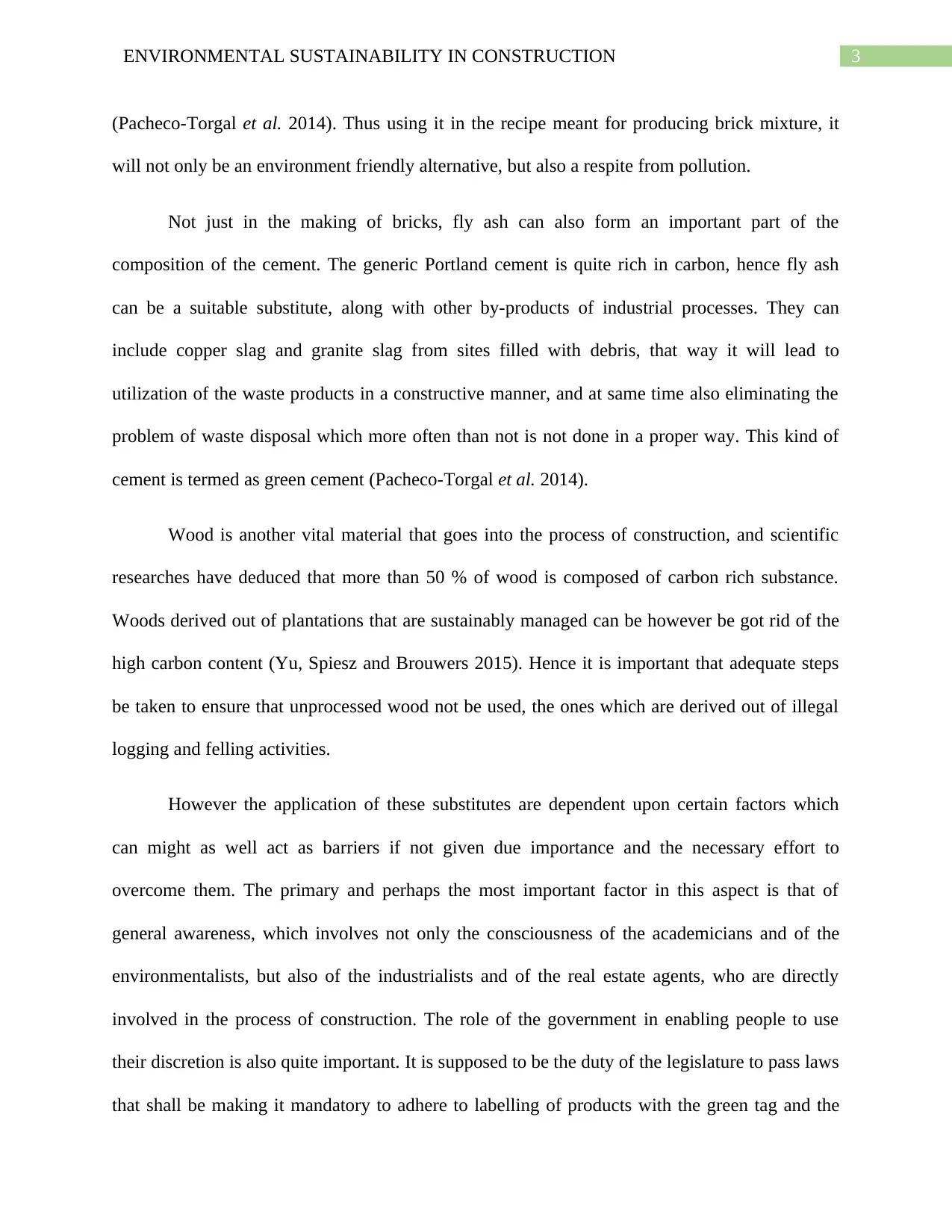
3ENVIRONMENTAL SUSTAINABILITY IN CONSTRUCTION
(Pacheco-Torgal et al. 2014). Thus using it in the recipe meant for producing brick mixture, it
will not only be an environment friendly alternative, but also a respite from pollution.
Not just in the making of bricks, fly ash can also form an important part of the
composition of the cement. The generic Portland cement is quite rich in carbon, hence fly ash
can be a suitable substitute, along with other by-products of industrial processes. They can
include copper slag and granite slag from sites filled with debris, that way it will lead to
utilization of the waste products in a constructive manner, and at same time also eliminating the
problem of waste disposal which more often than not is not done in a proper way. This kind of
cement is termed as green cement (Pacheco-Torgal et al. 2014).
Wood is another vital material that goes into the process of construction, and scientific
researches have deduced that more than 50 % of wood is composed of carbon rich substance.
Woods derived out of plantations that are sustainably managed can be however be got rid of the
high carbon content (Yu, Spiesz and Brouwers 2015). Hence it is important that adequate steps
be taken to ensure that unprocessed wood not be used, the ones which are derived out of illegal
logging and felling activities.
However the application of these substitutes are dependent upon certain factors which
can might as well act as barriers if not given due importance and the necessary effort to
overcome them. The primary and perhaps the most important factor in this aspect is that of
general awareness, which involves not only the consciousness of the academicians and of the
environmentalists, but also of the industrialists and of the real estate agents, who are directly
involved in the process of construction. The role of the government in enabling people to use
their discretion is also quite important. It is supposed to be the duty of the legislature to pass laws
that shall be making it mandatory to adhere to labelling of products with the green tag and the
(Pacheco-Torgal et al. 2014). Thus using it in the recipe meant for producing brick mixture, it
will not only be an environment friendly alternative, but also a respite from pollution.
Not just in the making of bricks, fly ash can also form an important part of the
composition of the cement. The generic Portland cement is quite rich in carbon, hence fly ash
can be a suitable substitute, along with other by-products of industrial processes. They can
include copper slag and granite slag from sites filled with debris, that way it will lead to
utilization of the waste products in a constructive manner, and at same time also eliminating the
problem of waste disposal which more often than not is not done in a proper way. This kind of
cement is termed as green cement (Pacheco-Torgal et al. 2014).
Wood is another vital material that goes into the process of construction, and scientific
researches have deduced that more than 50 % of wood is composed of carbon rich substance.
Woods derived out of plantations that are sustainably managed can be however be got rid of the
high carbon content (Yu, Spiesz and Brouwers 2015). Hence it is important that adequate steps
be taken to ensure that unprocessed wood not be used, the ones which are derived out of illegal
logging and felling activities.
However the application of these substitutes are dependent upon certain factors which
can might as well act as barriers if not given due importance and the necessary effort to
overcome them. The primary and perhaps the most important factor in this aspect is that of
general awareness, which involves not only the consciousness of the academicians and of the
environmentalists, but also of the industrialists and of the real estate agents, who are directly
involved in the process of construction. The role of the government in enabling people to use
their discretion is also quite important. It is supposed to be the duty of the legislature to pass laws
that shall be making it mandatory to adhere to labelling of products with the green tag and the
Paraphrase This Document
Need a fresh take? Get an instant paraphrase of this document with our AI Paraphraser
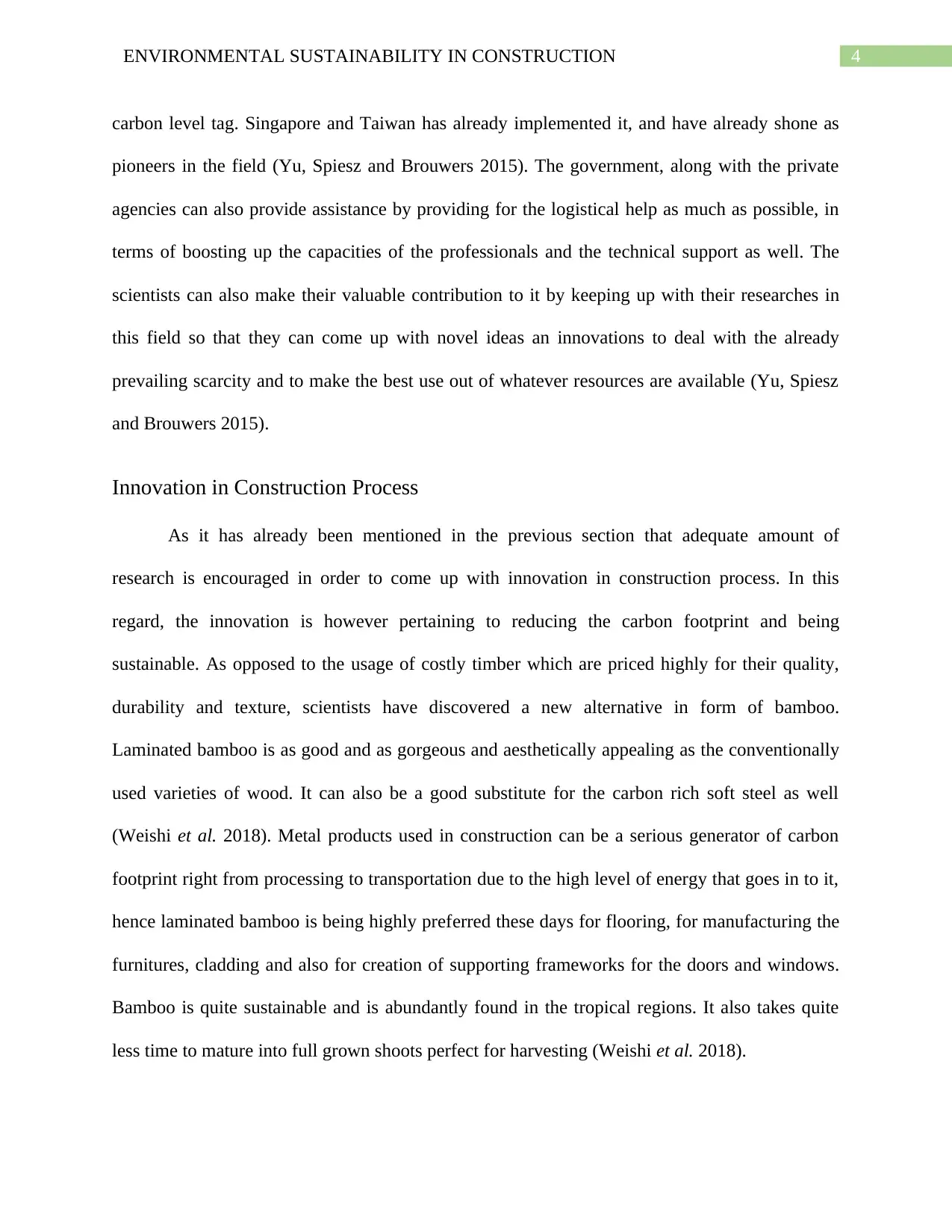
4ENVIRONMENTAL SUSTAINABILITY IN CONSTRUCTION
carbon level tag. Singapore and Taiwan has already implemented it, and have already shone as
pioneers in the field (Yu, Spiesz and Brouwers 2015). The government, along with the private
agencies can also provide assistance by providing for the logistical help as much as possible, in
terms of boosting up the capacities of the professionals and the technical support as well. The
scientists can also make their valuable contribution to it by keeping up with their researches in
this field so that they can come up with novel ideas an innovations to deal with the already
prevailing scarcity and to make the best use out of whatever resources are available (Yu, Spiesz
and Brouwers 2015).
Innovation in Construction Process
As it has already been mentioned in the previous section that adequate amount of
research is encouraged in order to come up with innovation in construction process. In this
regard, the innovation is however pertaining to reducing the carbon footprint and being
sustainable. As opposed to the usage of costly timber which are priced highly for their quality,
durability and texture, scientists have discovered a new alternative in form of bamboo.
Laminated bamboo is as good and as gorgeous and aesthetically appealing as the conventionally
used varieties of wood. It can also be a good substitute for the carbon rich soft steel as well
(Weishi et al. 2018). Metal products used in construction can be a serious generator of carbon
footprint right from processing to transportation due to the high level of energy that goes in to it,
hence laminated bamboo is being highly preferred these days for flooring, for manufacturing the
furnitures, cladding and also for creation of supporting frameworks for the doors and windows.
Bamboo is quite sustainable and is abundantly found in the tropical regions. It also takes quite
less time to mature into full grown shoots perfect for harvesting (Weishi et al. 2018).
carbon level tag. Singapore and Taiwan has already implemented it, and have already shone as
pioneers in the field (Yu, Spiesz and Brouwers 2015). The government, along with the private
agencies can also provide assistance by providing for the logistical help as much as possible, in
terms of boosting up the capacities of the professionals and the technical support as well. The
scientists can also make their valuable contribution to it by keeping up with their researches in
this field so that they can come up with novel ideas an innovations to deal with the already
prevailing scarcity and to make the best use out of whatever resources are available (Yu, Spiesz
and Brouwers 2015).
Innovation in Construction Process
As it has already been mentioned in the previous section that adequate amount of
research is encouraged in order to come up with innovation in construction process. In this
regard, the innovation is however pertaining to reducing the carbon footprint and being
sustainable. As opposed to the usage of costly timber which are priced highly for their quality,
durability and texture, scientists have discovered a new alternative in form of bamboo.
Laminated bamboo is as good and as gorgeous and aesthetically appealing as the conventionally
used varieties of wood. It can also be a good substitute for the carbon rich soft steel as well
(Weishi et al. 2018). Metal products used in construction can be a serious generator of carbon
footprint right from processing to transportation due to the high level of energy that goes in to it,
hence laminated bamboo is being highly preferred these days for flooring, for manufacturing the
furnitures, cladding and also for creation of supporting frameworks for the doors and windows.
Bamboo is quite sustainable and is abundantly found in the tropical regions. It also takes quite
less time to mature into full grown shoots perfect for harvesting (Weishi et al. 2018).
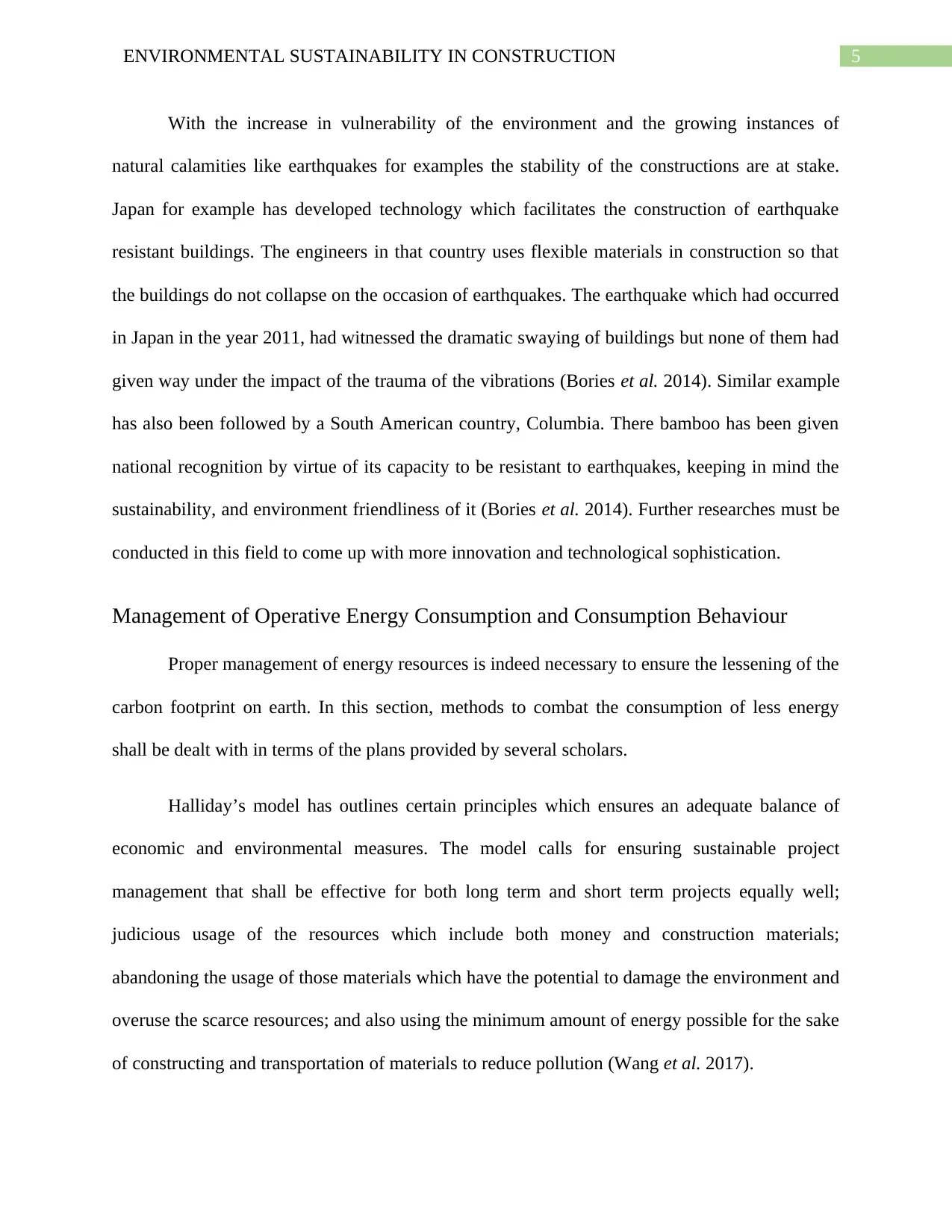
5ENVIRONMENTAL SUSTAINABILITY IN CONSTRUCTION
With the increase in vulnerability of the environment and the growing instances of
natural calamities like earthquakes for examples the stability of the constructions are at stake.
Japan for example has developed technology which facilitates the construction of earthquake
resistant buildings. The engineers in that country uses flexible materials in construction so that
the buildings do not collapse on the occasion of earthquakes. The earthquake which had occurred
in Japan in the year 2011, had witnessed the dramatic swaying of buildings but none of them had
given way under the impact of the trauma of the vibrations (Bories et al. 2014). Similar example
has also been followed by a South American country, Columbia. There bamboo has been given
national recognition by virtue of its capacity to be resistant to earthquakes, keeping in mind the
sustainability, and environment friendliness of it (Bories et al. 2014). Further researches must be
conducted in this field to come up with more innovation and technological sophistication.
Management of Operative Energy Consumption and Consumption Behaviour
Proper management of energy resources is indeed necessary to ensure the lessening of the
carbon footprint on earth. In this section, methods to combat the consumption of less energy
shall be dealt with in terms of the plans provided by several scholars.
Halliday’s model has outlines certain principles which ensures an adequate balance of
economic and environmental measures. The model calls for ensuring sustainable project
management that shall be effective for both long term and short term projects equally well;
judicious usage of the resources which include both money and construction materials;
abandoning the usage of those materials which have the potential to damage the environment and
overuse the scarce resources; and also using the minimum amount of energy possible for the sake
of constructing and transportation of materials to reduce pollution (Wang et al. 2017).
With the increase in vulnerability of the environment and the growing instances of
natural calamities like earthquakes for examples the stability of the constructions are at stake.
Japan for example has developed technology which facilitates the construction of earthquake
resistant buildings. The engineers in that country uses flexible materials in construction so that
the buildings do not collapse on the occasion of earthquakes. The earthquake which had occurred
in Japan in the year 2011, had witnessed the dramatic swaying of buildings but none of them had
given way under the impact of the trauma of the vibrations (Bories et al. 2014). Similar example
has also been followed by a South American country, Columbia. There bamboo has been given
national recognition by virtue of its capacity to be resistant to earthquakes, keeping in mind the
sustainability, and environment friendliness of it (Bories et al. 2014). Further researches must be
conducted in this field to come up with more innovation and technological sophistication.
Management of Operative Energy Consumption and Consumption Behaviour
Proper management of energy resources is indeed necessary to ensure the lessening of the
carbon footprint on earth. In this section, methods to combat the consumption of less energy
shall be dealt with in terms of the plans provided by several scholars.
Halliday’s model has outlines certain principles which ensures an adequate balance of
economic and environmental measures. The model calls for ensuring sustainable project
management that shall be effective for both long term and short term projects equally well;
judicious usage of the resources which include both money and construction materials;
abandoning the usage of those materials which have the potential to damage the environment and
overuse the scarce resources; and also using the minimum amount of energy possible for the sake
of constructing and transportation of materials to reduce pollution (Wang et al. 2017).
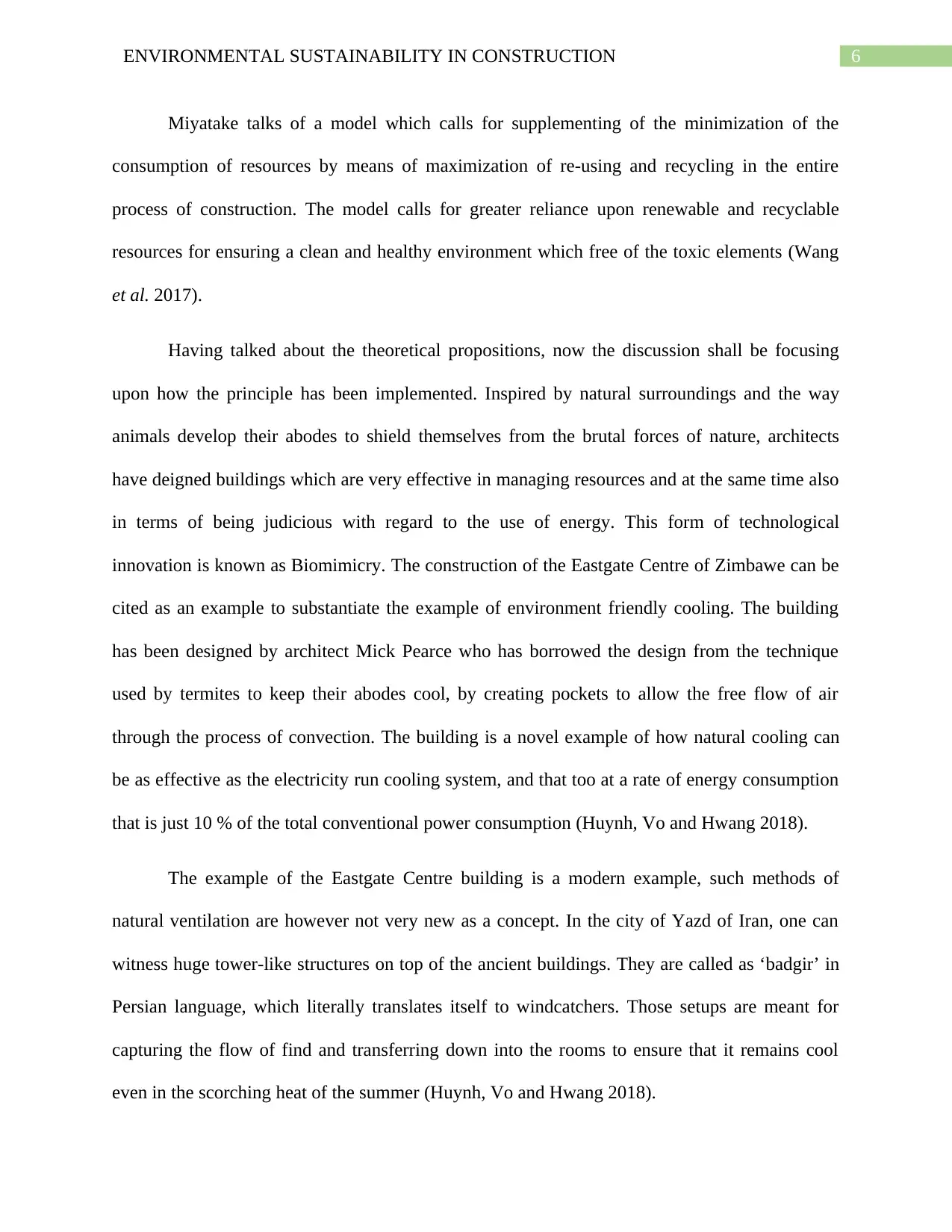
6ENVIRONMENTAL SUSTAINABILITY IN CONSTRUCTION
Miyatake talks of a model which calls for supplementing of the minimization of the
consumption of resources by means of maximization of re-using and recycling in the entire
process of construction. The model calls for greater reliance upon renewable and recyclable
resources for ensuring a clean and healthy environment which free of the toxic elements (Wang
et al. 2017).
Having talked about the theoretical propositions, now the discussion shall be focusing
upon how the principle has been implemented. Inspired by natural surroundings and the way
animals develop their abodes to shield themselves from the brutal forces of nature, architects
have deigned buildings which are very effective in managing resources and at the same time also
in terms of being judicious with regard to the use of energy. This form of technological
innovation is known as Biomimicry. The construction of the Eastgate Centre of Zimbawe can be
cited as an example to substantiate the example of environment friendly cooling. The building
has been designed by architect Mick Pearce who has borrowed the design from the technique
used by termites to keep their abodes cool, by creating pockets to allow the free flow of air
through the process of convection. The building is a novel example of how natural cooling can
be as effective as the electricity run cooling system, and that too at a rate of energy consumption
that is just 10 % of the total conventional power consumption (Huynh, Vo and Hwang 2018).
The example of the Eastgate Centre building is a modern example, such methods of
natural ventilation are however not very new as a concept. In the city of Yazd of Iran, one can
witness huge tower-like structures on top of the ancient buildings. They are called as ‘badgir’ in
Persian language, which literally translates itself to windcatchers. Those setups are meant for
capturing the flow of find and transferring down into the rooms to ensure that it remains cool
even in the scorching heat of the summer (Huynh, Vo and Hwang 2018).
Miyatake talks of a model which calls for supplementing of the minimization of the
consumption of resources by means of maximization of re-using and recycling in the entire
process of construction. The model calls for greater reliance upon renewable and recyclable
resources for ensuring a clean and healthy environment which free of the toxic elements (Wang
et al. 2017).
Having talked about the theoretical propositions, now the discussion shall be focusing
upon how the principle has been implemented. Inspired by natural surroundings and the way
animals develop their abodes to shield themselves from the brutal forces of nature, architects
have deigned buildings which are very effective in managing resources and at the same time also
in terms of being judicious with regard to the use of energy. This form of technological
innovation is known as Biomimicry. The construction of the Eastgate Centre of Zimbawe can be
cited as an example to substantiate the example of environment friendly cooling. The building
has been designed by architect Mick Pearce who has borrowed the design from the technique
used by termites to keep their abodes cool, by creating pockets to allow the free flow of air
through the process of convection. The building is a novel example of how natural cooling can
be as effective as the electricity run cooling system, and that too at a rate of energy consumption
that is just 10 % of the total conventional power consumption (Huynh, Vo and Hwang 2018).
The example of the Eastgate Centre building is a modern example, such methods of
natural ventilation are however not very new as a concept. In the city of Yazd of Iran, one can
witness huge tower-like structures on top of the ancient buildings. They are called as ‘badgir’ in
Persian language, which literally translates itself to windcatchers. Those setups are meant for
capturing the flow of find and transferring down into the rooms to ensure that it remains cool
even in the scorching heat of the summer (Huynh, Vo and Hwang 2018).
Secure Best Marks with AI Grader
Need help grading? Try our AI Grader for instant feedback on your assignments.
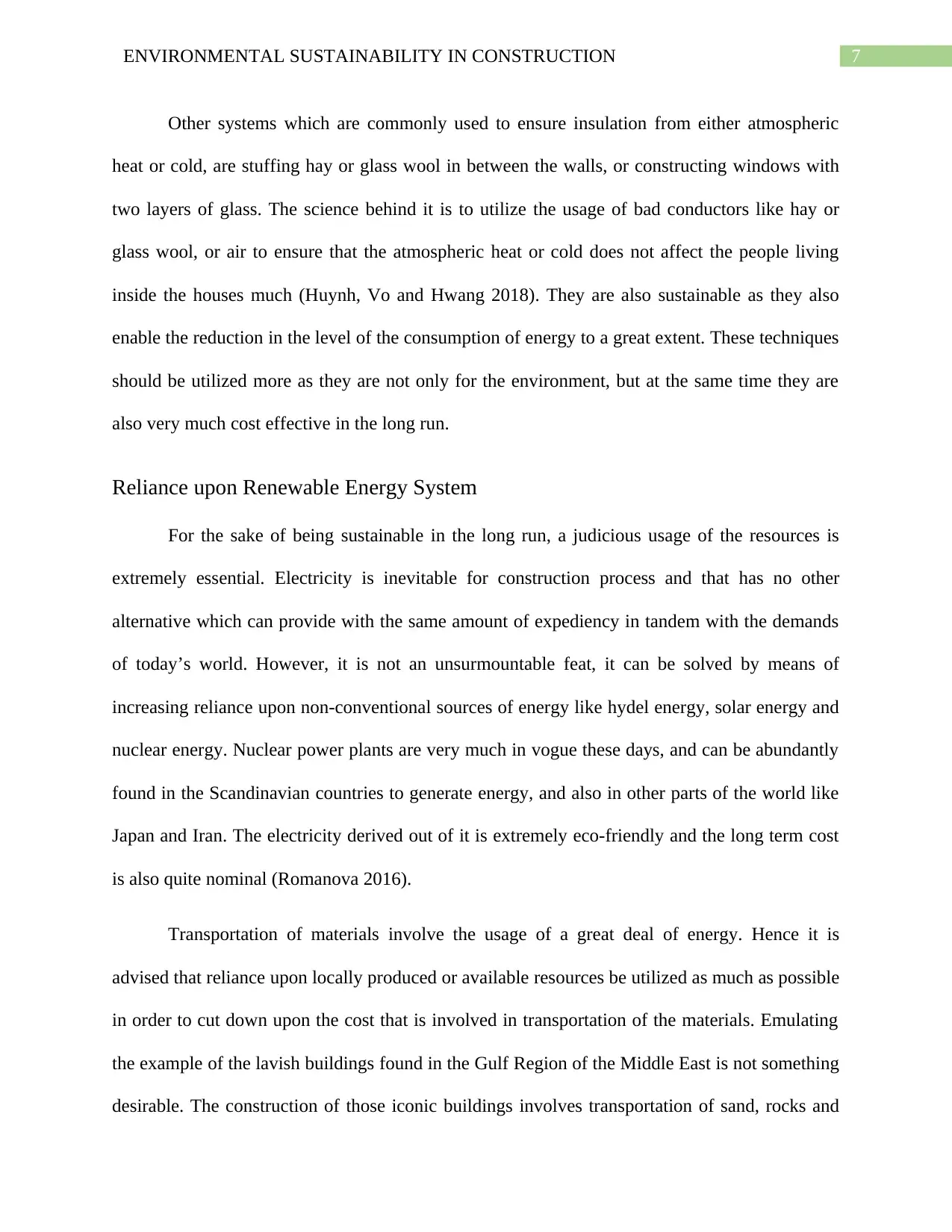
7ENVIRONMENTAL SUSTAINABILITY IN CONSTRUCTION
Other systems which are commonly used to ensure insulation from either atmospheric
heat or cold, are stuffing hay or glass wool in between the walls, or constructing windows with
two layers of glass. The science behind it is to utilize the usage of bad conductors like hay or
glass wool, or air to ensure that the atmospheric heat or cold does not affect the people living
inside the houses much (Huynh, Vo and Hwang 2018). They are also sustainable as they also
enable the reduction in the level of the consumption of energy to a great extent. These techniques
should be utilized more as they are not only for the environment, but at the same time they are
also very much cost effective in the long run.
Reliance upon Renewable Energy System
For the sake of being sustainable in the long run, a judicious usage of the resources is
extremely essential. Electricity is inevitable for construction process and that has no other
alternative which can provide with the same amount of expediency in tandem with the demands
of today’s world. However, it is not an unsurmountable feat, it can be solved by means of
increasing reliance upon non-conventional sources of energy like hydel energy, solar energy and
nuclear energy. Nuclear power plants are very much in vogue these days, and can be abundantly
found in the Scandinavian countries to generate energy, and also in other parts of the world like
Japan and Iran. The electricity derived out of it is extremely eco-friendly and the long term cost
is also quite nominal (Romanova 2016).
Transportation of materials involve the usage of a great deal of energy. Hence it is
advised that reliance upon locally produced or available resources be utilized as much as possible
in order to cut down upon the cost that is involved in transportation of the materials. Emulating
the example of the lavish buildings found in the Gulf Region of the Middle East is not something
desirable. The construction of those iconic buildings involves transportation of sand, rocks and
Other systems which are commonly used to ensure insulation from either atmospheric
heat or cold, are stuffing hay or glass wool in between the walls, or constructing windows with
two layers of glass. The science behind it is to utilize the usage of bad conductors like hay or
glass wool, or air to ensure that the atmospheric heat or cold does not affect the people living
inside the houses much (Huynh, Vo and Hwang 2018). They are also sustainable as they also
enable the reduction in the level of the consumption of energy to a great extent. These techniques
should be utilized more as they are not only for the environment, but at the same time they are
also very much cost effective in the long run.
Reliance upon Renewable Energy System
For the sake of being sustainable in the long run, a judicious usage of the resources is
extremely essential. Electricity is inevitable for construction process and that has no other
alternative which can provide with the same amount of expediency in tandem with the demands
of today’s world. However, it is not an unsurmountable feat, it can be solved by means of
increasing reliance upon non-conventional sources of energy like hydel energy, solar energy and
nuclear energy. Nuclear power plants are very much in vogue these days, and can be abundantly
found in the Scandinavian countries to generate energy, and also in other parts of the world like
Japan and Iran. The electricity derived out of it is extremely eco-friendly and the long term cost
is also quite nominal (Romanova 2016).
Transportation of materials involve the usage of a great deal of energy. Hence it is
advised that reliance upon locally produced or available resources be utilized as much as possible
in order to cut down upon the cost that is involved in transportation of the materials. Emulating
the example of the lavish buildings found in the Gulf Region of the Middle East is not something
desirable. The construction of those iconic buildings involves transportation of sand, rocks and
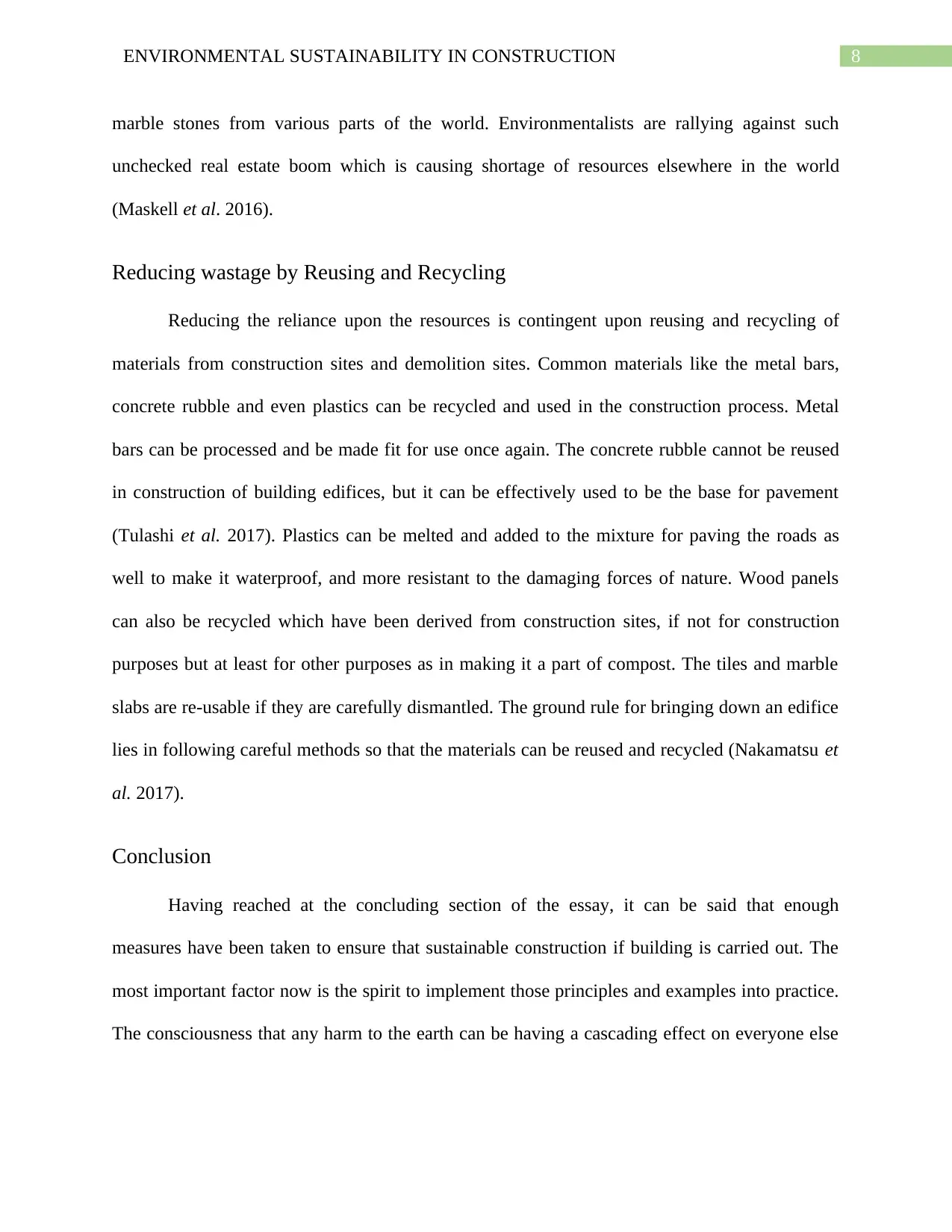
8ENVIRONMENTAL SUSTAINABILITY IN CONSTRUCTION
marble stones from various parts of the world. Environmentalists are rallying against such
unchecked real estate boom which is causing shortage of resources elsewhere in the world
(Maskell et al. 2016).
Reducing wastage by Reusing and Recycling
Reducing the reliance upon the resources is contingent upon reusing and recycling of
materials from construction sites and demolition sites. Common materials like the metal bars,
concrete rubble and even plastics can be recycled and used in the construction process. Metal
bars can be processed and be made fit for use once again. The concrete rubble cannot be reused
in construction of building edifices, but it can be effectively used to be the base for pavement
(Tulashi et al. 2017). Plastics can be melted and added to the mixture for paving the roads as
well to make it waterproof, and more resistant to the damaging forces of nature. Wood panels
can also be recycled which have been derived from construction sites, if not for construction
purposes but at least for other purposes as in making it a part of compost. The tiles and marble
slabs are re-usable if they are carefully dismantled. The ground rule for bringing down an edifice
lies in following careful methods so that the materials can be reused and recycled (Nakamatsu et
al. 2017).
Conclusion
Having reached at the concluding section of the essay, it can be said that enough
measures have been taken to ensure that sustainable construction if building is carried out. The
most important factor now is the spirit to implement those principles and examples into practice.
The consciousness that any harm to the earth can be having a cascading effect on everyone else
marble stones from various parts of the world. Environmentalists are rallying against such
unchecked real estate boom which is causing shortage of resources elsewhere in the world
(Maskell et al. 2016).
Reducing wastage by Reusing and Recycling
Reducing the reliance upon the resources is contingent upon reusing and recycling of
materials from construction sites and demolition sites. Common materials like the metal bars,
concrete rubble and even plastics can be recycled and used in the construction process. Metal
bars can be processed and be made fit for use once again. The concrete rubble cannot be reused
in construction of building edifices, but it can be effectively used to be the base for pavement
(Tulashi et al. 2017). Plastics can be melted and added to the mixture for paving the roads as
well to make it waterproof, and more resistant to the damaging forces of nature. Wood panels
can also be recycled which have been derived from construction sites, if not for construction
purposes but at least for other purposes as in making it a part of compost. The tiles and marble
slabs are re-usable if they are carefully dismantled. The ground rule for bringing down an edifice
lies in following careful methods so that the materials can be reused and recycled (Nakamatsu et
al. 2017).
Conclusion
Having reached at the concluding section of the essay, it can be said that enough
measures have been taken to ensure that sustainable construction if building is carried out. The
most important factor now is the spirit to implement those principles and examples into practice.
The consciousness that any harm to the earth can be having a cascading effect on everyone else
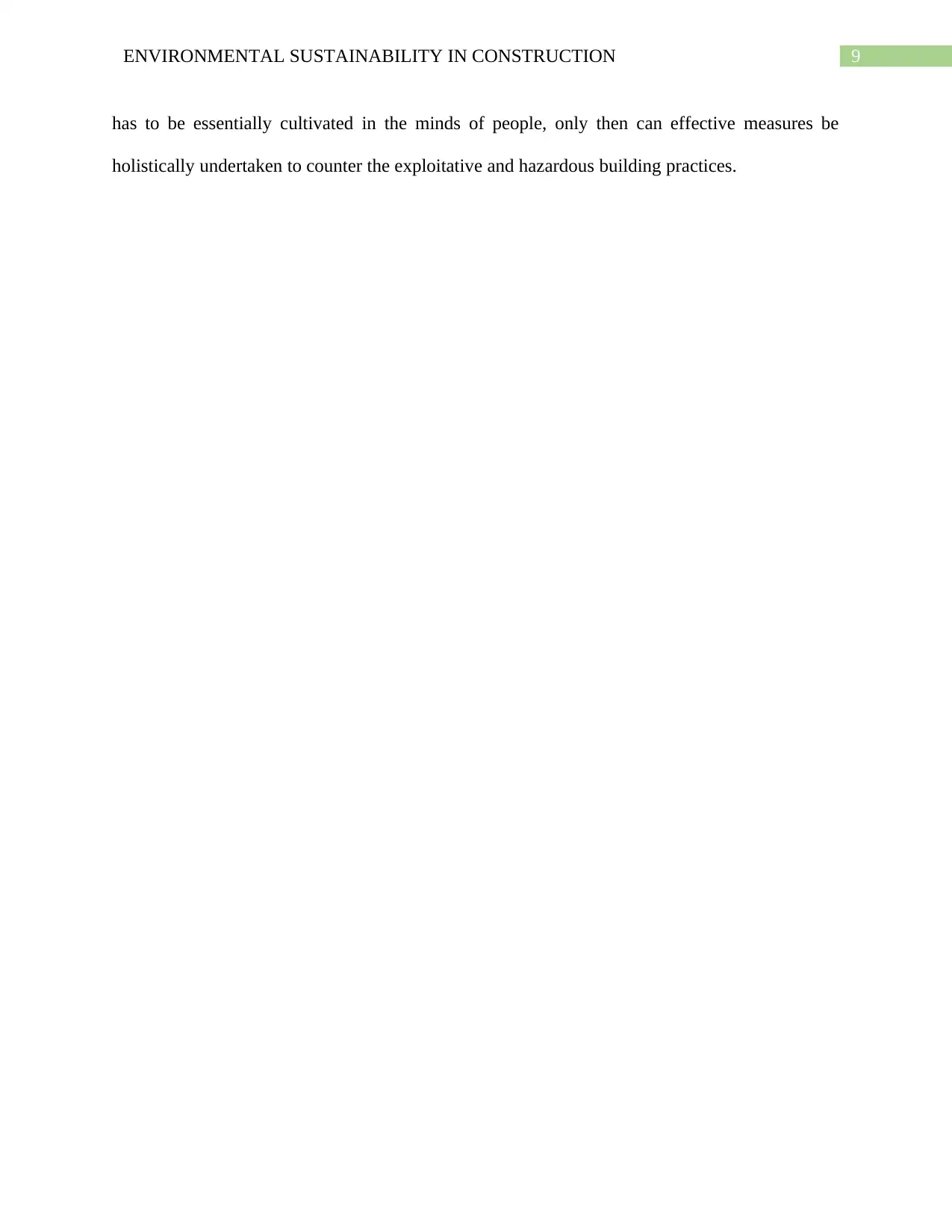
9ENVIRONMENTAL SUSTAINABILITY IN CONSTRUCTION
has to be essentially cultivated in the minds of people, only then can effective measures be
holistically undertaken to counter the exploitative and hazardous building practices.
has to be essentially cultivated in the minds of people, only then can effective measures be
holistically undertaken to counter the exploitative and hazardous building practices.
Paraphrase This Document
Need a fresh take? Get an instant paraphrase of this document with our AI Paraphraser

10ENVIRONMENTAL SUSTAINABILITY IN CONSTRUCTION
References
Adazabra, A.N., Viruthagiri, G. and Ravisankar, R., 2016. Cleaner production in the Shea
industry via the recovery of Spent Shea Waste for reuse in the construction sector. Journal of
Cleaner Production, 122, pp.335-344.
Bories, C., Borredon, M.E., Vedrenne, E. and Vilarem, G., 2014. Development of eco-friendly
porous fired clay bricks using pore-forming agents: A review. Journal of environmental
management, 143, pp.186-196.
Huynh, T.P., Vo, D.H. and Hwang, C.L., 2018. Engineering and durability properties of eco-
friendly mortar using cement-free SRF binder. Construction and Building Materials, 160,
pp.145-155.
Maskell, D., Reddy, V., Heath, A. and Walker, P., 2016. Modern earth construction techniques–
an overview. In 16th International Brick and Block Masonry Conference, 2016. University of
Bath.
Nakamatsu, J., Kim, S., Ayarza, J., Ramírez, E., Elgegren, M. and Aguilar, R., 2017. Eco-
friendly modification of earthen construction with carrageenan: Water durability and mechanical
assessment. Construction and Building Materials, 139, pp.193-202.
Pacheco-Torgal, F., Cabeza, L.F., Labrincha, J. and De Magalhaes, A.G., 2014. Eco-efficient
construction and building materials: life cycle assessment (LCA), eco-labelling and case studies.
woodhead Publishing.
Park, K.G. and Kim, J., 2018. The Design Characteristics of Nature Inspired Architecture.
Modern Environmental Science and Engineering, 4(5), pp.381-414.
References
Adazabra, A.N., Viruthagiri, G. and Ravisankar, R., 2016. Cleaner production in the Shea
industry via the recovery of Spent Shea Waste for reuse in the construction sector. Journal of
Cleaner Production, 122, pp.335-344.
Bories, C., Borredon, M.E., Vedrenne, E. and Vilarem, G., 2014. Development of eco-friendly
porous fired clay bricks using pore-forming agents: A review. Journal of environmental
management, 143, pp.186-196.
Huynh, T.P., Vo, D.H. and Hwang, C.L., 2018. Engineering and durability properties of eco-
friendly mortar using cement-free SRF binder. Construction and Building Materials, 160,
pp.145-155.
Maskell, D., Reddy, V., Heath, A. and Walker, P., 2016. Modern earth construction techniques–
an overview. In 16th International Brick and Block Masonry Conference, 2016. University of
Bath.
Nakamatsu, J., Kim, S., Ayarza, J., Ramírez, E., Elgegren, M. and Aguilar, R., 2017. Eco-
friendly modification of earthen construction with carrageenan: Water durability and mechanical
assessment. Construction and Building Materials, 139, pp.193-202.
Pacheco-Torgal, F., Cabeza, L.F., Labrincha, J. and De Magalhaes, A.G., 2014. Eco-efficient
construction and building materials: life cycle assessment (LCA), eco-labelling and case studies.
woodhead Publishing.
Park, K.G. and Kim, J., 2018. The Design Characteristics of Nature Inspired Architecture.
Modern Environmental Science and Engineering, 4(5), pp.381-414.
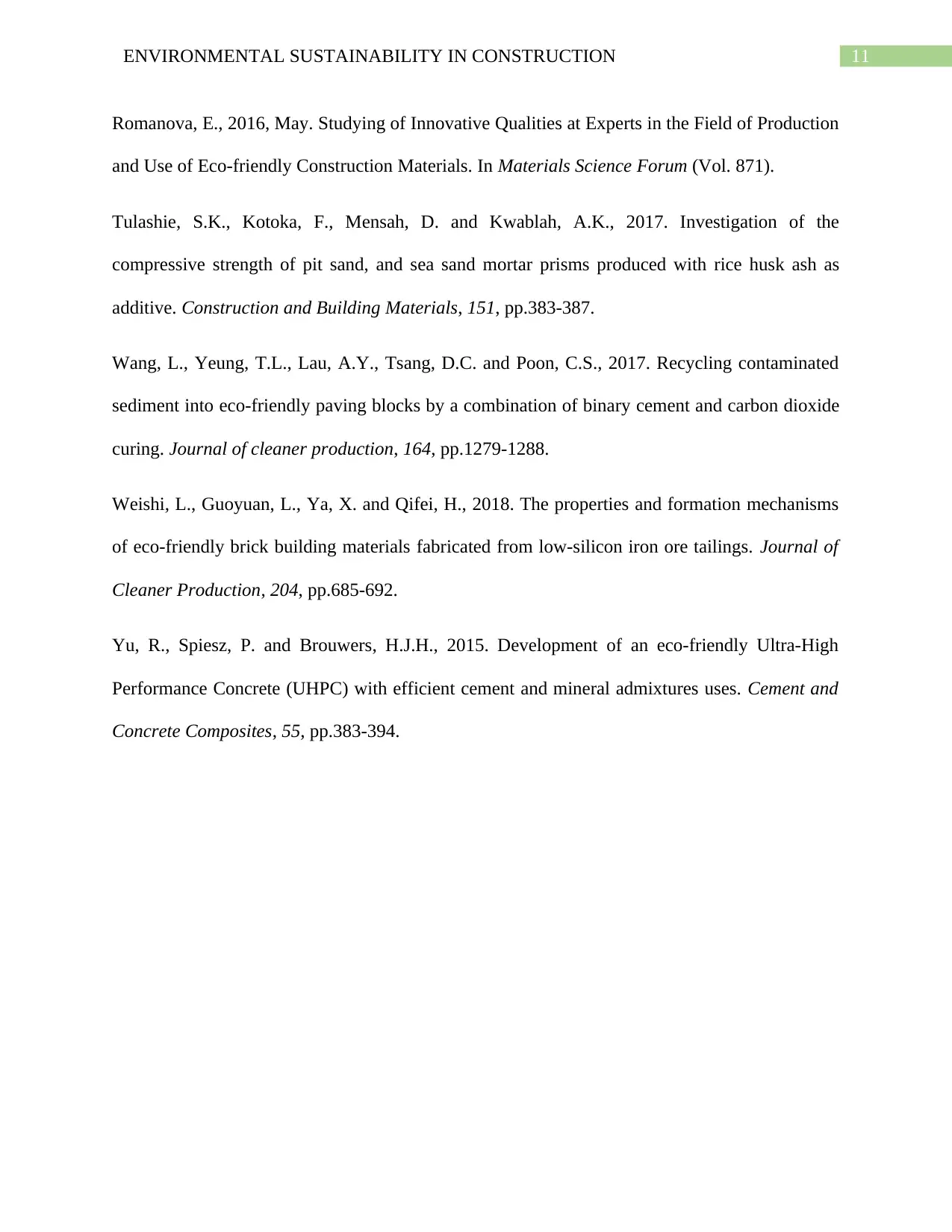
11ENVIRONMENTAL SUSTAINABILITY IN CONSTRUCTION
Romanova, E., 2016, May. Studying of Innovative Qualities at Experts in the Field of Production
and Use of Eco-friendly Construction Materials. In Materials Science Forum (Vol. 871).
Tulashie, S.K., Kotoka, F., Mensah, D. and Kwablah, A.K., 2017. Investigation of the
compressive strength of pit sand, and sea sand mortar prisms produced with rice husk ash as
additive. Construction and Building Materials, 151, pp.383-387.
Wang, L., Yeung, T.L., Lau, A.Y., Tsang, D.C. and Poon, C.S., 2017. Recycling contaminated
sediment into eco-friendly paving blocks by a combination of binary cement and carbon dioxide
curing. Journal of cleaner production, 164, pp.1279-1288.
Weishi, L., Guoyuan, L., Ya, X. and Qifei, H., 2018. The properties and formation mechanisms
of eco-friendly brick building materials fabricated from low-silicon iron ore tailings. Journal of
Cleaner Production, 204, pp.685-692.
Yu, R., Spiesz, P. and Brouwers, H.J.H., 2015. Development of an eco-friendly Ultra-High
Performance Concrete (UHPC) with efficient cement and mineral admixtures uses. Cement and
Concrete Composites, 55, pp.383-394.
Romanova, E., 2016, May. Studying of Innovative Qualities at Experts in the Field of Production
and Use of Eco-friendly Construction Materials. In Materials Science Forum (Vol. 871).
Tulashie, S.K., Kotoka, F., Mensah, D. and Kwablah, A.K., 2017. Investigation of the
compressive strength of pit sand, and sea sand mortar prisms produced with rice husk ash as
additive. Construction and Building Materials, 151, pp.383-387.
Wang, L., Yeung, T.L., Lau, A.Y., Tsang, D.C. and Poon, C.S., 2017. Recycling contaminated
sediment into eco-friendly paving blocks by a combination of binary cement and carbon dioxide
curing. Journal of cleaner production, 164, pp.1279-1288.
Weishi, L., Guoyuan, L., Ya, X. and Qifei, H., 2018. The properties and formation mechanisms
of eco-friendly brick building materials fabricated from low-silicon iron ore tailings. Journal of
Cleaner Production, 204, pp.685-692.
Yu, R., Spiesz, P. and Brouwers, H.J.H., 2015. Development of an eco-friendly Ultra-High
Performance Concrete (UHPC) with efficient cement and mineral admixtures uses. Cement and
Concrete Composites, 55, pp.383-394.
1 out of 12
Your All-in-One AI-Powered Toolkit for Academic Success.
+13062052269
info@desklib.com
Available 24*7 on WhatsApp / Email
![[object Object]](/_next/static/media/star-bottom.7253800d.svg)
Unlock your academic potential
© 2024 | Zucol Services PVT LTD | All rights reserved.


